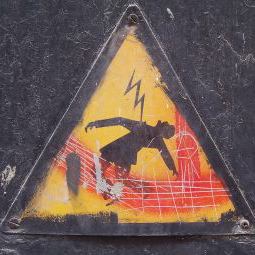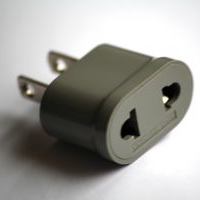Travel News
Converters, Adapters and Transformers, Oh My! – A Guide to Foreign Electricity
 In this wired age, travelers want to be plugged in, whether it’s a computer, MP3 player, or simply their hair dryer.
In this wired age, travelers want to be plugged in, whether it’s a computer, MP3 player, or simply their hair dryer.
And even if most Americans know they might need some type of adapter, converter or transformer in order to use their electric devices abroad, they might not know exactly when to use what.
Let’s start with terms.
There are two basic types of equipment you might need abroad in terms of electricity.
One is a plug adapter, and the other is a converter or transformer.
A plug adapter is usually small, inexpensive, and straightforward: it basically makes your American plug fit into the socket of the country you are visiting, the idea being that there is already a built-in converter or transformer in your electrical appliance, or that you will be using a separate converter or transformer with the adapter.
SELECTING THE RIGHT PLUG ADAPTER
 Fortunately for world travelers, a wide variety of plug adapters (as well as converters) are readily available online as well as at most electronics stores like Radio Shack, Best Buy, even Wal-Mart. Since you’ll almost always need a plug adapter for overseas travel, it’s comforting to know that they’re cheap. How cheap? How about 99 cents?
Fortunately for world travelers, a wide variety of plug adapters (as well as converters) are readily available online as well as at most electronics stores like Radio Shack, Best Buy, even Wal-Mart. Since you’ll almost always need a plug adapter for overseas travel, it’s comforting to know that they’re cheap. How cheap? How about 99 cents?
Now keep in mind that price is for the simplest adapter available, the kind that will work with only one type of plug and socket. But if you’re traveling to only one place and know you’ll encounter only one type of plug, it’s definitely the cheapest way to go.
If you think your travels could take you to more than one place (or more specifically, to where there’s more than one type of plug), universal plug adapters or sets of adapters are still fairly cheap. BestBuy, CompUSA, and Circuit City, for example, all offer different types of universal adapters for $24.99.
Now remember, if your electronic device can handle a range of voltages or can be switched between them, a plug adapter may be all you need for a variety of countries.
But if it doesn’t, or if you’re planning on being there more than a week or two [long-term usage at different-than-expected voltages can degrade some devices], a voltage converter — or for some equipment, a transformer — is what you’ll want.
If you’ll be traveling to a country where the electricity supply is less than stable, having a surge protector as part of your adapter or converter can be a great idea. It can also be a bit of added peace of mind if you’re traveling with expensive electronics.
CONVERTERS V. TRANSFORMERS
Converters and transformers convert or transform the voltage of electricity from the plug into whatever the proper level is for the plugged-in appliance. The difference between the two lies in how the device actually converts the voltage current. To reduce 220V to 110V, for example, a converter chops the “sine waves” (the shape of the AC power bursts) in half, whereas a transformer alters the length of the sine waves.
This is a very important difference, because electronic devices such as computers or printers require a full sine wave for operation, and therefore can operate only with a transformer.
On the other hand, electric appliances, such as a hair dryer, function with either a full or a half sine wave, so can be operated with either a converter or a transformer. Keep in mind that transformers are usually much larger, heavier and much more expensive than converters.
So if you are about to purchase an electronic device such as a computer, and know you are going to travel, you should consider buying one that is dual voltage, if possible, to avoid having to drag a massive transformer with you overseas.
Remember, both electric appliances and electronic devices can work with a transformer (but the latter won’t work with a converter), so when in doubt, use a transformer.
Depending on the device you want to use, you may not need a converter or a transformer at all, but you’ll probably always need a plug adapter. Check out the back or side of the device you’d like to bring with you. If it states a range of accepted voltages, like 110V-240V, it should be able to handle the major voltages: 110V and 220V, or the new European standard, 230V.
Some items (even your hair dryer) might have a switch on them to change between the two major standards.
Other electronic equipment, like most clock radios, shavers, and cell phone chargers, will have only one voltage listed (or perhaps none at all) and will require a transformer.
For a country-by-country listing of voltages, frequencies and plugs, check out:
KROPLA.com
Here are two other lists you can double-check with:
VOLTAGE VALET.com
Or for information on voltage, adapters and hertz needed for the specific country you are traveling to, check out:
Also, you may see that some of these sites sell dual-voltage appliances, like irons and hair dryers, which could make sense for frequent travelers.
Generally speaking, the Americas (except parts of Latin America) and most of the Caribbean use 120V, while much of the rest of the world tends toward 220V-230V. Just remember that the power supply can be different in different parts of the same country — with Brazil being a probable prime example — with several different voltages and plugs used in various parts of the country.
With voltage, a little variance is acceptable and even expected, so for example, many 220V devices will be okay in 230V or 240V sockets. Ditto for 110V, 115V and 120V.
 SELECTING THE RIGHT CONVERTER/TRANSFORMER
SELECTING THE RIGHT CONVERTER/TRANSFORMER
If your desired electronic device isn’t dual voltage, you’ll need a converter or transformer. There are a wide variety of them available from major retailers both online and off. Regardless of which converter or transformer you ultimately choose, the crucial factor here is making sure that the one you choose has the proper capacity.
There’s a trade-off to keep in mind here. Generally, the higher the transformer’s capacity, the larger, heavier and more expensive it will be. So you’ll want to get one that can handle the wattage of your chosen appliance, without being unnecessarily large.
The importance of this part of the process can’t be stressed enough: the power level that the converter/transformer handles is crucial to making sure you electronics work safely. To be on the safe side, you’ll need a converter that can handle at least 10-20% more than the highest-wattage device you plan to use. So if you’re planning on taking along a 1400-watt hair dryer, you’ll want one that can handle at least 1600 watts.
Keep in mind that if you’re headed to Japan, you’ll need a special Japanese transformer, as they’re really the only major country using the 100V standard.
ABOARD CRUISE SHIPS
Most cruise ships today actually offer two standard types of voltage and plugs (usually, American and European) to please travelers from all over the globe. This may not be the case with more expeditionary types of voyages (to Antarctica, for example), where the ships weren’t solely designed for the accommodation of international travelers. So be sure to find out ahead of time about your specific ship’s capabilities — you may learn you won’t need anything in the way of plug adapters, converters or transformers.
LONG-TERM USAGE
Depending on how long you’re planning on using electronics abroad, it may make more sense to go ahead and purchase what you need in the country itself and not mess with converters, transformers or adapters at all.
Obviously, this makes more sense with certain devices than it does with others. A new laptop might be a bit expensive for a three-week jaunt through Europe, but a new hair dryer could actually be less expensive than a new converter, for example.
So don’t be afraid to take electronics overseas, just be prepared.
By Matthew Calcara for PeterGreenberg.com.
Check out our Travel Gadget Spotlight: Packing More in your Carry-on.
And don’t miss our entire section devoted to Travel Gadgets.












